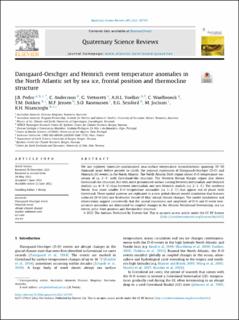Dansgaard-Oeschger and Heinrich event temperature anomalies in the North Atlantic set by sea ice, frontal position and thermocline structure
Pedro, J.B.; Andersson, Carin; Vettoretti, G.; Voelker, A.H.L.; Waelbroeck, C.; Dokken, Trond Martin; Jensen, Mari Fjalstad; Rasmussen, S.O.; Sessford, Evangeline; Jochum, M.; Nisancioglu, Kerim Hestnes
Journal article, Peer reviewed
Published version

Åpne
Permanent lenke
https://hdl.handle.net/11250/3023666Utgivelsesdato
2022Metadata
Vis full innførselSamlinger
- Department of Earth Science [1034]
- Registrations from Cristin [9487]
Sammendrag
We use eighteen timescale-synchronised near-surface temperature reconstructions spanning 10–50 thousand years before present to clarify the regional expression of Dansgaard-Oeschger (D-O) and Heinrich (H) events in the North Atlantic. The North Atlantic Drift region shows D-O temperature variations of ca. 2–5° with Greenland-like structure. The Western Iberian Margin region also shows Greenland-like structure, but with more pronounced surface cooling between interstadials and Heinrich stadials (ca. 6–9 °C) than between interstadials and non-Heinrich stadials (ca. 2–3 °C). The southern Nordic Seas show smaller D-O temperature anomalies (ca. 1–2 °C) that appear out of phase with Greenland. These spatial patterns are replicated in a new global climate model simulation that features unforced (D-O-like) and freshwater forced (H-like) abrupt climate changes. The model simulations and observations suggest consistently that the spatial expression and amplitude of D-O and H event temperature anomalies are dominated by coupled changes in the Atlantic Meridional Overturning, sea ice extent, polar front position and thermocline structure.
